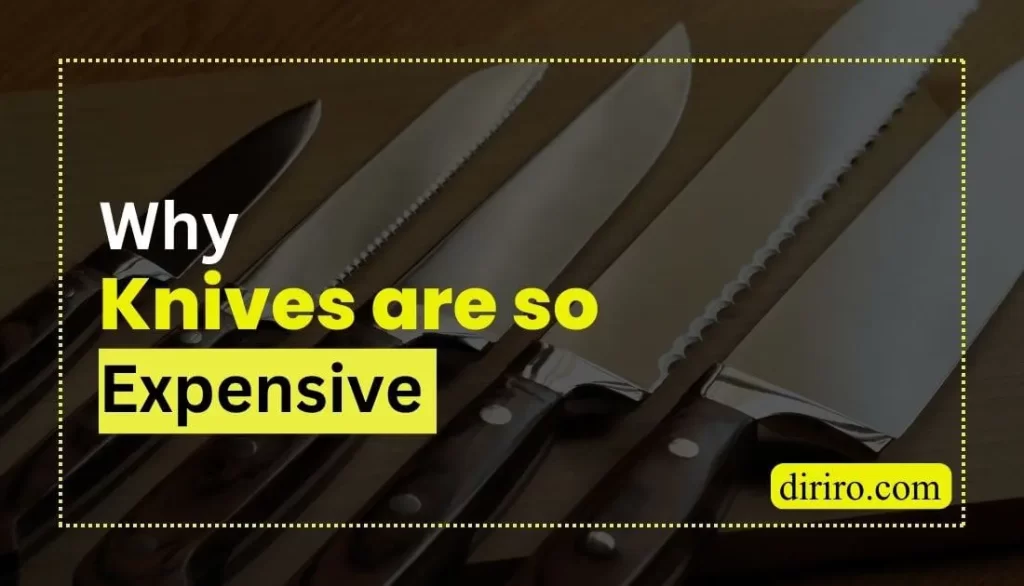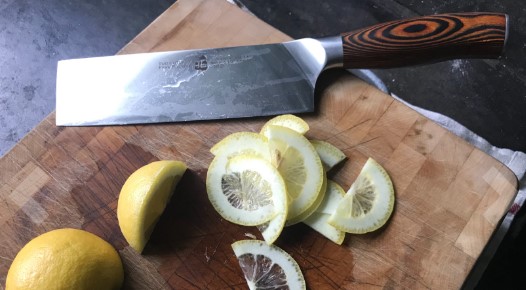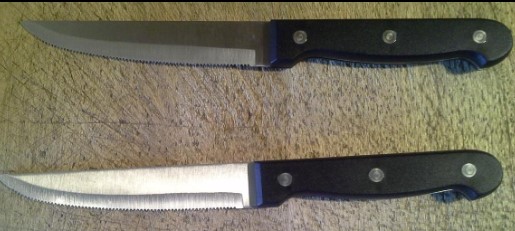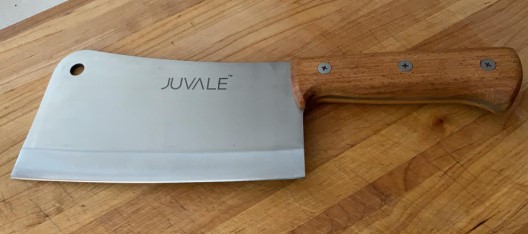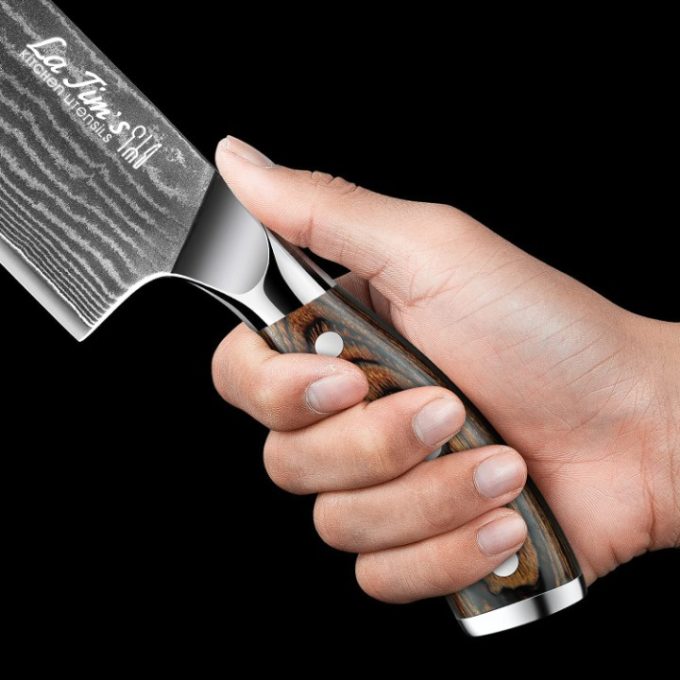I have found 10 reasons why Knives are so Expensive. A good set of knives is essential to making memorable family meals where everyone can relax and have fun.
It is likely that you will find an array of different options in front of you when looking at different knife sets.
One thing is certain about high-quality knives: they are expensive.
Read Also: Best Kitchen Knife Set Under $300
Knives are so expensive? Here are 10 reasons why:
1. The blade is made of high-quality steel
In addition to having a high-quality blade, an expensive knife should also have a handle made of premium materials.
Steel blades are commonly used in knives, but steel comes in a wide range of quality levels.
The better the steel, the longer it will last and will be able to deal with chips.
There is also the possibility of it looking more attractive.
The four basic types of steel are as follows.
Various types of steel are classified based on their alloy elements and how they are made:
- Steels containing carbon are typically more than 2% carbon, while cast iron is less than 2%. A low, medium, and high score is assigned to each of these categories. High carbon steel is the best steel for knives.
- Alloy steel is a steel that can be alloyed with a wide variety of different metals, such as aluminum, copper, manganese, and silicon. Steel of this type is especially versatile because of the different alloys that are used.
- Steel made specifically for toolmaking: Tool steel is steel used for making tools. Different types of steel are made based on their use, such as water-hardening steel, oil-hardening steel, high-speed steel, and shock-resistant steel.
- Stainless steel: Chromium is the only element in stainless steel. The content of chromium will range between 10.5% and 30%. In addition to being the shiniest option, it is also the most corrosion-resistant.
The best knives are made from carbon steel or stainless steel because they are both exceptionally strong materials.
Most knives sold on the market are made of either carbon steel or stainless steel, with stainless steel being the more popular choice despite its higher price.
Carbon steel is priced at $1.038 per pound when cold-rolled. It costs $1.67 per pound to buy stainless steel.
2. Titanium Or Carbon Fiber Handle
A knife’s handle needs to look good and also provide an exceptional grip when a consumer is using it.
If you don’t hold your knife correctly, you could suffer a serious injury. It’s important to choose a knife with an easy-to-hold handle.
Plastic and rubber are the most common materials used to make knife handles.
In spite of their effectiveness, these handles aren’t the best for gripping and may degrade over time.
There’s no doubt that metal options are more expensive.
Among the three metals available, aluminum, steel, or titanium are the most popular.
Corrosion can occur quickly if aluminum is used as a reinforcement material.
When it comes to metal handles, titanium offers the best option.
Corrosion is not an issue with it because it’s strong, long-lasting, attractive, and rustproof.
Rods made of aluminum cost only $0.32, while those made of titanium cost $11.
In addition, the best knives are designed with advanced gripping technology to avoid slips when in use.
3. Warranty
Manufacturers, especially those selling knives on the higher end of the spectrum, should stand by their products, and for the most part, they do.
Companies offer warranties to ensure that their products will be replaced in accordance with the terms of the warranty.
There is rarely a warranty included with cheap knives.
It is still possible to get a lifetime warranty on the best knives, so you will have protection for as long as you own them.
Among the brands that offer lifetime warranties (but not all of them), there are:
- Big Green Egg
- Chicago Cutlery
- Cutco
- Esee
You should carefully read all warranties before making a purchase.
A lifetime warranty may include a “no questions asked” clause, stating that they will replace any knife you bring to them, whereas others may include more stringent requirements.
Consumers may only get a replacement knife if they can prove there was a defect at the time they purchased it.
In the event of misplacement or theft of the product, warranties do not cover the loss.
4. Forged Vs. Stamped
It is possible to get blades either stamped or forged, and each has its own advantages and disadvantages.
The best knives, however, are forged knives, especially if you are looking for a top-rated knife.
Stamped
Knives made from stamped metal are made using a huge sheet of metal.
In the process of producing the knife, a large sheet of metal is cut out with a cutting machine.
Simple and inexpensive, this process takes only a few minutes. There are, however, some shortcomings, such as its intricacy and durability.
Forged
Blades made of forged steel are reinforced and strengthened by melting molecules together.
Blades on these knives are more rigid and can withstand more abuse than those on stamped knives.
In addition, they can be sharpened more easily.
Knives made from forged steel, however, are considerably more expensive.
By looking at the bolster, you can determine whether your knife is stamped or forged.
There is a wide metal lip between the blade and handle of the knife known as the bolster.
An extension of the finger can sometimes be seen in the handle, creating a tang.
Bolsters and tangs are only found on forged knives.
5. Overhead Costs
Distributing knives, hiring employees, and packaging all affect the manufacturing and sale of knives.
A. Distribution
Gas money is needed to transport knives from the manufacturer to their destination.
Consumers can pick up their knives from local retailers after buyers transport them.
Online sales can also provide the seller with the option of delivering the knife to the consumer’s home.
It is common for major manufacturers to have several manufacturing plants spread across the country or the globe to be able to reach more stores and customers without having to travel large distances.
To provide cheaper delivery to New Yorkers, a knife manufacturer in California may open a new manufacturing facility in the city.
As a result, sales are increased since the product remains more affordable.
Distribution companies save money over time by handling their own distribution.
Trucks and truck drivers are not typically part of a company’s budget, so they hire somebody else to handle it.
B. Employees
There is a whole team that works on making cooking knives and delivering them to your kitchen.
Company executives, truck drivers, warehouse workers, and salespeople are paid.
In order to increase customer satisfaction, it is crucial to have a full-service staff that can assist customers with questions or claims under warranty.
Small companies, however, cannot afford the costs associated with a properly staffed facility.
The best customer service can be provided by national chains thanks to this.
C. Packaging
When knives are unexpectedly found outside of their packaging, they can be dangerous.
In addition to causing problems for consumers and manufacturers, this can lead to lawsuits.
Although knives are sharp, cheap packaging cannot protect them from knives.
The use of high-quality packaging by high-end companies prevents problems from occurring before they happen, from the moment the knife is created to the moment it is opened by the consumer.
6. Safety Features
Approximately 350,000 injuries are reported each year as a result of knives.
People use knives improperly most of the time, resulting in accidents.
The following tips can help prevent accidents caused by kitchen knives:
- Ensure that your cutting board is stable when cutting items
- Make sure you are using the right tool for the job
- Make sure you wear full-coverage shoes when cooking so you don’t catch a knife that falls.
- Keep your distance from yourself
People who use dull knives are also more likely to experience an accident.
The sharpness of knives makes them safer than dull knives, contrary to popular belief.
Furthermore, high-end knives will include additional safety features.
In order to ensure safety, nonslip handles are of utmost importance.
It is also possible to purchase knives that come with accessories that increase safety while using them.
7. Accessories
Knives require the proper tools and accessories to be used and cared for properly.
You may get the following accessories:
- Sharpener
- Block
- Cleaning materials
- Sheath
Some knives include a sharpener so that you can maintain the sharpness regardless of how often you use them.
The majority of sharpeners are made of steel and come with a handle.
In order to sharpen the knife, simply slide it across the steel rod a few times when you notice that it has become dull.
A sharpener is probably included with better knives since they don’t need as much sharpening.
In order to maintain the sharpness of your knife after each use, you need to sharpen it more often based on how much you use it and how well it maintains its sharpness.
In addition to fitting into a block for safe and convenient storage, the knives should also fit into a knife holder.
It is even possible to use some blocks as sharpeners so that you can sharpen your knife every single time you remove it from the block.
Knives need to be cleaned properly, and shouldn’t go in the dishwasher.
The typical procedure is to wash your knives by hand with dish soap and water.
A cheese-based sauce, for example, can be removed by soaking the knife in warm water.
Always point the knife away from you and work carefully when you wash it.
While this will work for standard cleaning, you may also get a special cleanser to use on your knives periodically or special microfiber washcloths.
Finally, some knives come with a sheath that keeps them safe while in a kitchen drawer, while also ensuring no one accidentally cuts themselves on the knife.
8. Full Set
A single knife will not be able to meet all of your kitchen slicing and cutting needs.
A larger blade may be required for some jobs, but smaller, more precise blades may be required for others.
The reason why you’re unlikely to find a knife without a full set that includes everything you’d need (and more) is because of this.
This knife block not only includes everything you need, but everything is stylish and well-matched.
A manufacturer will, of course, replace a lost knife if you request one.
There are several types of knives that you might find in a knife set, including:
1. Chef’s knife
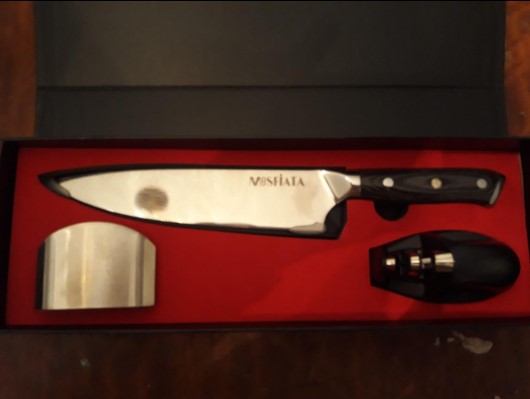
There is no doubt that the chef’s knife is one of the most common kitchen tools.
Depending on the user’s size and preference, it usually measures between six and twelve inches.
This knife is considered to be an important kitchen tool since it can handle most tasks.
2. Utility knife

Utility knives are small and are used for trimming, chopping, and other smaller tasks that require a chef’s knife for safety reasons.
3. Nakiri Bocho
With its thin, wide blade, this Japanese cleaver is ideal for quickly chopping vegetables.
4. Steak knife
The thin, serrated blade of steak knives makes them ideal for tearing into steaks. They are one step above butter knives.
5. Paring knife
For precise work like garnishing, a three- to four-inch paring knife blade works best.
6. Cleaver
Cleavers are large knives in the kitchen because of their wide blades.
In particular, when it comes to cutting through bones or pumpkins, it is the best knife to use.
As well as crushing large items, such as garlic, the heavy blade can also handle smaller items.
7. Bread knife
Their serrated edges set them apart from other knives.
The blades can reach up to 10 inches in length, which is perfect for cutting bread and cakes.
8. Boning knife
In the name of its purpose, a boning knife is a small knife that is specifically designed to cut through bones to remove meat from them.
The majority of boning knives come with a blade curved slightly upward and ranging from three to eight inches in length.
9. Fillet knife
Fish fillet knives are similar to boning knives because they are designed specifically for the purpose of filleting fish.
There is a slight difference in flexibility between fillet knives and steak knives.
The boning knife and filet knife are often combined by manufacturers to simplify things.
10. Shears
The difference between shears and knives is that shears are scissors.
The knives are just as useful for cutting things in the kitchen as well.
They are great for cutting herbs and slicing pizza, but are also handy for breaking down whole chickens.
There will be a wide variety of knives in a set, but not all sets will include all kinds.
It is important to determine what kind of knives you wish to own before purchasing a set.
There is no doubt that the more options you have, the better your chances are of finding the perfect solution.
It is only natural that a set of knives will cost more than one knife, thus contributing to the high price.
This does not, however, imply that you should purchase knives one by one.
By purchasing the set, you’ll be able to save significantly over purchasing each knife separately.
In your knife block, you may not necessarily need every kind of knife you see.
There is more of a desire and convenience factor involved than a necessity.
The majority of people prefer to purchase no more than three or four knives to cover all of their kitchen cutting needs.
9. Quality Control
Quality control is an important part of the manufacturing process for high-end knives.
As part of their testing, they make sure that the knives hold up under various conditions.
The knives are also further tested for durability and sharpness to ensure they do not break while in use.
It is expensive to conduct extensive quality control.
In addition, it forces many otherwise usable products to go to waste.
Quality control reduces returns, warranty claims, and dissatisfied customers in the end, which is why companies invest in quality control.
Quality control can be divided into four types:
- Safety procedures and product safety features prevent accidents from occurring before they happen.
- A quality control problem is discovered during the appraisal process while manufacturing is taking place.
- Identifying failures before products leave the retailer is called an internal failure.
- Failure during the consumer’s use of the product: failure that occurs after the product is placed into their hands.
Manufacturing knives involves quality control, which is paid for by every knife manufacturer.
Whenever they lose money because of products that don’t meet their standards, they raise the prices.
10. Aesthetic Appeal
In addition to being cutting tools, knives can serve a variety of other functions as well.
Stainless steel knives, especially ones with shiny blades, add a stylish element to even the most stylish kitchens.
Even the blade may be decorated with fishbones or elaborate Damascus patterns.
You can also find intricate handles in various styles and colors, which add a lot to the look of the knife.
It’s common for craftspeople to embellish their knives with dramatic designs that are sure to stir up a lively conversation.
What’s your idea of an unusual gift?
There are two different patterns on these sets: a cosmos pattern and a Jurassic pattern.
Conclusion
When it comes to knives, high-quality knives are more durable, perform more accurately, and look better compared to their low-quality counterparts.
Your knife set doesn’t necessarily have to contain every single knife.
By purchasing a full set, you will have everything you need to cut any food you come across in the kitchen and you will save money over buying each item individually.
Look for knives that will be the last set you will ever need when shopping for new ones.
